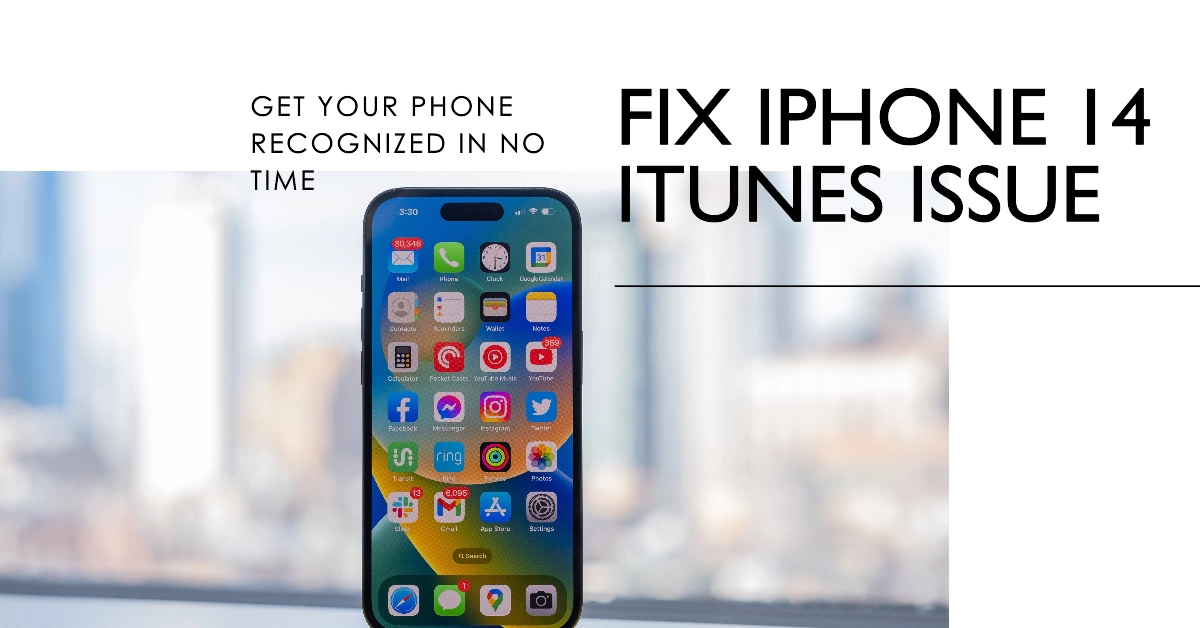Encountering issues where iTunes fails to detect your iPhone 14 can be frustrating. This is a prevalent concern, but fret not, as there are several potential solutions to establish a successful connection.
This troubleshooting guide will outline a series of steps to get your iPhone recognized and functioning seamlessly within the iTunes environment.
Sections
Identifying the Underlying Causes
Here are some common reasons why your iPhone might not be recognized by your computer:
- Hardware Issues
- Damaged Lightning Cable: A faulty or frayed cable might not transmit data signals effectively.
- Dirty Ports: Dust or debris buildup in the Lightning port on your iPhone or the USB port on your computer can impede a proper connection.
- Faulty iPhone Port: In rare cases, physical damage to the Lightning port on your iPhone itself could be the culprit.
- Software Issues
- Outdated Software: An outdated version of iTunes, iOS on your iPhone, or your computer’s operating system might lead to compatibility issues.
- Software Glitches: Minor software glitches on either your iPhone or computer can sometimes cause temporary connection problems.
- Security Software Interference: Antivirus or firewall software might be configured to block the connection between your iPhone and iTunes.
- Communication Issues
- Unlocked and Trust Prompt: If your iPhone is locked or you haven’t granted trust to the computer, it won’t be recognized for data transfer.
- Incorrect Connection Method: On macOS Catalina and later, iTunes has been replaced by Finder for device management. Ensure you’re using the appropriate method for your operating system.
Basic Verification Procedures
1. System Reboot
Initiating a restart on both your iPhone and computer can often rectify minor software glitches.
- Power down both devices (your iPhone and computer) completely, and then proceed to turn them back on before attempting another connection.
2. Connection Verification
Meticulously examine the Lightning cable connection between your iPhone and computer.
- Ensure a certified Lightning cable is firmly plugged into both devices.
- Try using a different USB port on your computer, particularly if you’re utilizing a hub or docking station.
- Clean any debris or dust that might be obstructing the Lightning port on your iPhone.
3. Unlock and Trust
Verify that your iPhone is unlocked. When you connect it, a “Trust This Computer” prompt might appear on your iPhone screen.
- Grant authorization for this prompt to establish a trusted connection.
Software Updates
1. Update iTunes
Outdated iTunes software can lead to compatibility issues.
- Open iTunes and navigate to the Help menu (Mac) or Edit menu (Windows) and select “Check for Updates.”
- Install any available updates and restart iTunes upon completion.
2. Update iOS
An uncurrent iOS version on your iPhone might not be compatible with your present iTunes installation.
- Back up your iPhone data and update it to the latest iOS version by navigating through Settings > General > Software Update.
3. Update Computer Operating System
Outdated operating systems on your computer can hinder communication with iTunes.
- Ensure compatibility by updating your Mac to the latest macOS or your Windows PC to the most recent Windows version.
Advanced Troubleshooting Techniques
1. Security Software Deactivation
As a temporary measure, disable any antivirus or firewall software running on your computer. These programs might inadvertently interfere with the connection between your iPhone and iTunes.
- Remember to re-enable them after troubleshooting is complete.
2. Reset Location & Privacy Settings
- On your iPhone, navigate to Settings > General > Reset > Reset Location & Privacy.
This can potentially resolve issues caused by corrupted location or privacy settings.
3. Reinstall iTunes (Windows)
- For Windows machines, thoroughly uninstall the existing iTunes software and reinstall a fresh copy downloaded directly from Apple’s website (https://www.apple.com/itunes/).
This ensures you have the latest software components.
4. Utilize Finder (Mac)
On macOS Catalina and later, Apple has replaced iTunes with Finder for managing iOS devices.
- Connect your iPhone and launch a new Finder window. Your iPhone should be displayed in the sidebar under Locations.
If none of these solutions work, it’s recommended to contact Apple Support for further assistance.
Frequently Asked Questions
1. What if I don’t have access to a computer?
You can still manage your iPhone 14 without iTunes. Use iCloud backup for data and settings, and download apps directly from the App Store on your iPhone.
2. Can I use third-party software to manage my iPhone?
Several third-party programs offer similar functionalities to iTunes. However, Apple recommends using official Apple tools for optimal performance and security.
3. What if my iPhone is damaged?
Hardware damage to your iPhone’s Lightning port or internal components could be causing the connection issue. Contact Apple Support or an authorized service provider for a diagnosis.
4. Is there a way to transfer data between my iPhone and computer without iTunes?
Yes, you can use iCloud to backup and restore your iPhone, or use cloud storage services like Google Drive or Dropbox to transfer specific files.
5. How can I prevent this from happening again?
Keeping your iPhone and computer software updated can minimize compatibility issues. Additionally, using genuine Apple cables and avoiding dust buildup in the Lightning port can ensure a smooth connection.
